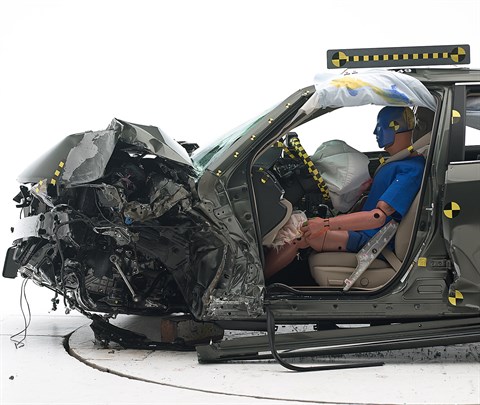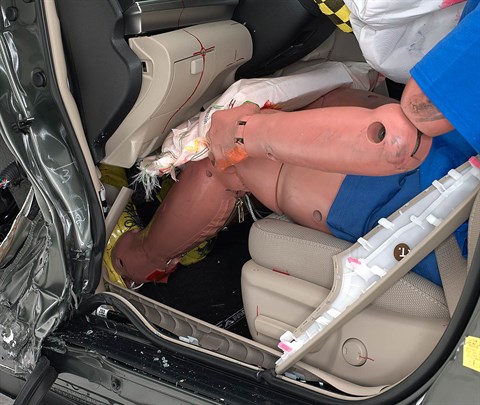Small overlap front: driver-side
Rating applies to 2015-17 models
Tested vehicle: 2014 Toyota Camry LE 4-door
The Toyota Camry was redesigned for the 2012 model year. Beginning with 2014 models built after December 2013, the front structure was modified to improve occupant protection in small overlap frontal crashes. (Information about when a specific vehicle was manufactured is on the certification label typically affixed to the car on the driver door or adjacent B-pillar.)
Beginning with 2015 models, the side curtain airbags were lengthened to further improve occupant protection in this same type of crash. Assessment of side airbag coverage is determined by the Institute based on a test of a 2015 model Camry conducted by Toyota. All other assessments, ratings, and vehicle specifications are based on an Institute test of a 2014 model Camry built after the front structure was modified.
| Evaluation criteria | Rating |
|---|---|
| Structure and safety cage | |
| Driver injury measures | |
| Head/neck | |
| Chest | |
| Hip/thigh | |
| Lower leg/foot | |
| Driver restraints and dummy kinematics | |

Action shot taken during the Institute's small overlap frontal crash test.

The dummy's position in relation to the door frame, steering wheel, and instrument panel after the crash test indicates that the driver's survival space was maintained reasonably well in the Institute's test.

Except for door hinge pillar deformation and parking brake pedal movement (pedal not visible), intrusion into the driver's space was reasonably well controlled, and risk of injuries to the dummy's legs and feet was low (Institute test car shown).
Moderate overlap front: original test
Rating applies to 2012-17 models
Tested vehicle: 2012 Toyota Camry LE 4-door
The Toyota Camry was redesigned for the 2012 model year. Frontal ratings are assigned by the Institute based on a test conducted by Toyota.
| Evaluation criteria | Rating |
|---|---|
| Overall evaluation | |
| Structure and safety cage | |
| Driver injury measures | |
| Head/neck | |
| Chest | |
| Leg/foot, left | |
| Leg/foot, right | |
| Driver restraints and dummy kinematics | |
Side: original test
Rating applies to 2012-17 models
Tested vehicle: 2012 Toyota Camry SE 4-door with standard front and rear head curtain airbags and standard front and rear seat-mounted torso airbags
The Toyota Camry was redesigned for the 2012 model year. Side ratings are assigned by the Institute based on a test conducted by Toyota.
| Evaluation criteria | Rating |
|---|---|
| Overall evaluation | |
| Structure and safety cage | |
| Driver injury measures | |
| Head/neck | |
| Torso | |
| Pelvis/leg | |
| Driver head protection | |
| Rear passenger injury measures | |
| Head/neck | |
| Torso | |
| Pelvis/leg | |
| Rear passenger head protection | |
Roof strength
Rating applies to 2012-17 models
Tested vehicle: 2012 Toyota Camry LE 4-door
| Overall evaluation | |
|---|---|
| Curb weight | 3,167 lbs |
| Peak force | 15,148 lbs |
| Strength-to-weight ratio | 4.78 |
Head restraints & seats
Seat type: Power cloth seats
| Overall evaluation | |
|---|---|
| Dynamic rating | |
| Seat/head restraint geometry |
About the head restraint & seat test
Currently, IIHS tests apply only to front seats.
Front crash prevention: vehicle-to-vehicle
Child seat anchors
Rating applies to 2015-17 models
| Evaluation criteria | Rating |
|---|---|
| Overall evaluation | |
| Vehicle trim | LE |
| Seat type | cloth |
This vehicle has 2 rear seating positions with complete child seat attachment (LATCH) hardware.
It has 1 additional seating position with a tether anchor only.
| Evaluation criteria | Rating |
|---|---|
| Overall evaluation | |
| Vehicle trim | LE |
| Seat type | cloth |
| Rating icon | Rating |
|---|---|
| G | Good |
| A | Acceptable |
| M | Marginal |
| P | Poor |
| Seating positions that rely on borrowed lower anchors or have only a tether anchor available are not rated. | |
thether anchor symbol | Tether anchor |
lower anchor symbol | Lower anchors |
| Lower anchor(s) can be borrowed from adjacent positions(s) | |
| No hardware available |
Details by seating position
| Position | Rating |
|---|---|
| 1 | |
| Tether anchor | |
| easy-to-find location | |
| no other hardware could be confused for anchor | |
| Lower anchors | |
| too deep in seat | |
| not too much force needed to attach | |
| easy to maneuver around anchors | |
| 2 | |
| Tether anchor | |
| easy-to-find location | |
| no other hardware could be confused for anchor | |
| Lower anchors | |
| none available | |
| 3 | |
| Tether anchor | |
| easy-to-find location | |
| no other hardware could be confused for anchor | |
| Lower anchors | |
| too deep in seat | |
| not too much force needed to attach | |
| easy to maneuver around anchors |
